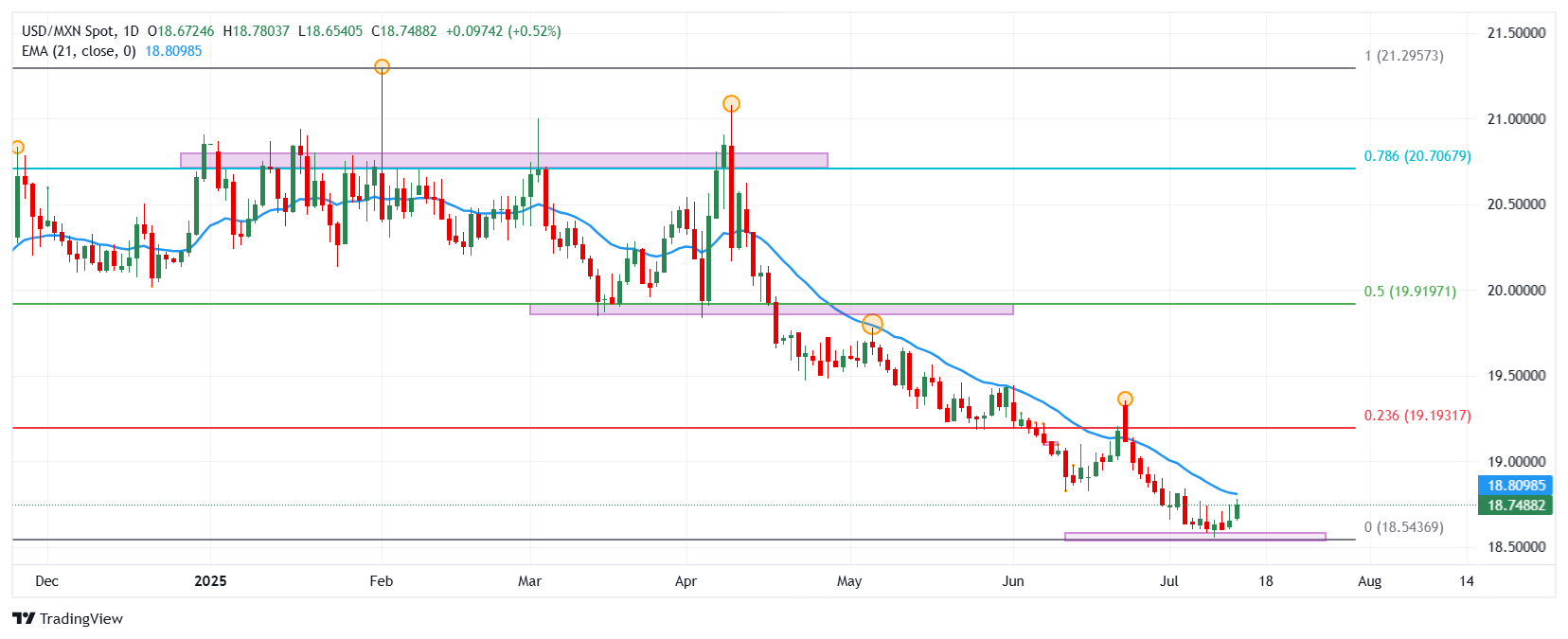- The USD/MXN rebounds 0.51% today, reaching maximums of July 3 in 18.74.
- The dollar index (DXY) advances 0.24% in the day, operating when writing about 98.11.
- The president of the United States, Donald Trump, announced the imposition of a 30% tariff to the goods from Mexico.
- The United States Consumption Price Index (CPI) will concentrate the attention of the operators, tomorrow.
The USD/MXN established a minimum daily in 18.65, finding buyers who promoted the parity to maximums not seen from July 3 in 18.78. At the moment, the USD/MXN operates over 18.74, winning 0.51% on Monday.
The Mexican weight loses ground after Trump’s tariff announcement
Donald Trump announced last Saturday, the imposition of a 30% rate to the original products of Mexico through a letter sent to President Claudia Sheinbaum. It is expected that these tariffs enter into force as of August 1, although investors expect a commercial agreement to be reached before this date.
On the other hand, the dollar index (DXY) trades on positive terrain, moving 0.24% on the first day of the week, visiting maximum of June 25 in 98.13, spinning four consecutive sessions with profits.
The economic agenda considers tomorrow the publication of the United States Consumer Price Index, the market consensus projects the increase of 2.7% year -on -year in June compared to 2.4% observed the previous month.
In the midst of this context, the Mexican peso is listed in the loss zone, while the USD/MXN rebuops 0.51% daily, reaching maximums of July 3 in 18.78, signing its second consecutive day upwards.
USD/MXN Price levels
The USD/MXN formed a short -term resistance given by the maximum of June 23 in 19.35. The next key resistance is observed in 19.78 Maximum of May 6 in convergence with the recoil at 38.2% of Fibonacci. To the south, the key support is located in 17.60, minimum of July 12, 2024.
USD/MXN daily graphics

Mexican peso – frequent questions
The Mexican weight (MXN) is the most commercialized currency among its Latin American peers. Its value is widely determined by the performance of the Mexican economy, the country’s central bank policy, the amount of foreign investment in the country and even remittance levels sent by Mexicans living abroad, particularly in the United States. Geopolitical trends can also affect MXN: for example, the Nearshoring process (or the decision of some companies to relocate the manufacturing capacity and supply chains closer to their countries of origin) is also considered a catalyst for the Mexican currency, since the country is considered a key manufacturing center in the American continent. Another catalyst for MXN is oil prices, since Mexico is a key exporter of the raw material.
The main objective of the Central Bank of Mexico, also known as Banxico, is to maintain inflation at low and stable levels (in or close to its 3%target, the midpoint of a tolerance band between 2%and 4%). To do this, the bank establishes an adequate level of interest rates. When inflation is too high, Banxico will try to control it by raising interest rates, which makes the indebtedness of homes and companies more cooling, thus cooling the demand and the economy in general. The highest interest rates are generally positive for Mexican weight (MXN), since they lead to higher yields, which makes the country a more attractive place for investors. On the contrary, lower interest rates tend to weaken the MXN.
The publication of macroeconomic data is key to evaluating the state of the economy and can have an impact on the valuation of the Mexican weight (MXN). A strong Mexican economy, based on high economic growth, low unemployment and high confidence is good for MXN. Not only attracts more foreign investment, but it can encourage the Bank of Mexico (Banxico) to increase interest rates, particularly if this fortress is accompanied by high inflation. However, if the economic data is weak, the MXN is likely to depreciate.
As an emerging market currency, the Mexican weight (MXN) tends to rise for periods of risk, or when investors perceive that the general market risks are low and, therefore, are eager to participate in investments that carry a higher risk. On the contrary, the MXN tends to weaken at times of market turbulence or economic uncertainty, since investors tend to sell higher risk assets and flee to the most stable safe shelters.
Source: Fx Street
I am Joshua Winder, a senior-level journalist and editor at World Stock Market. I specialize in covering news related to the stock market and economic trends. With more than 8 years of experience in this field, I have become an expert in financial reporting.







